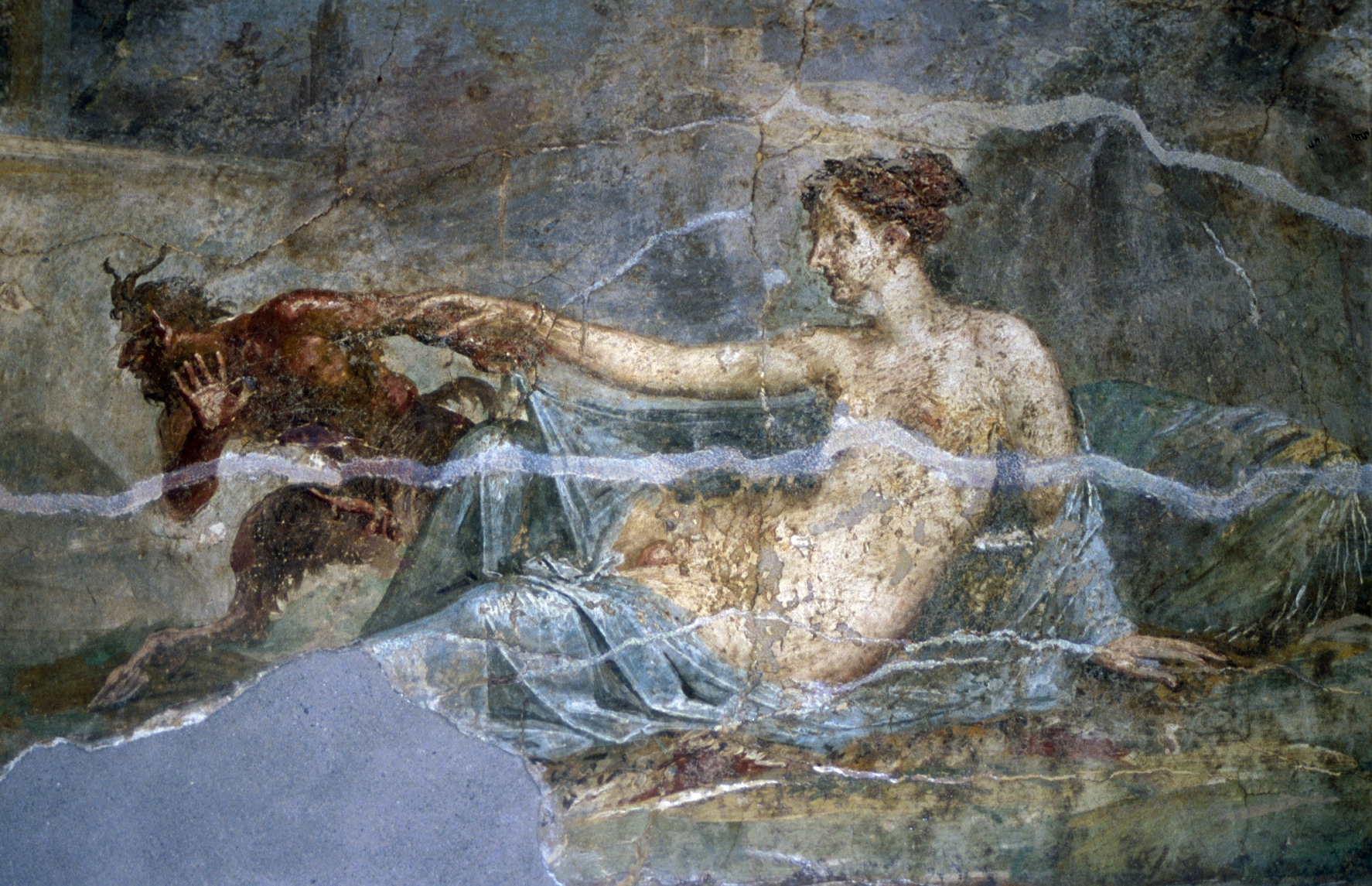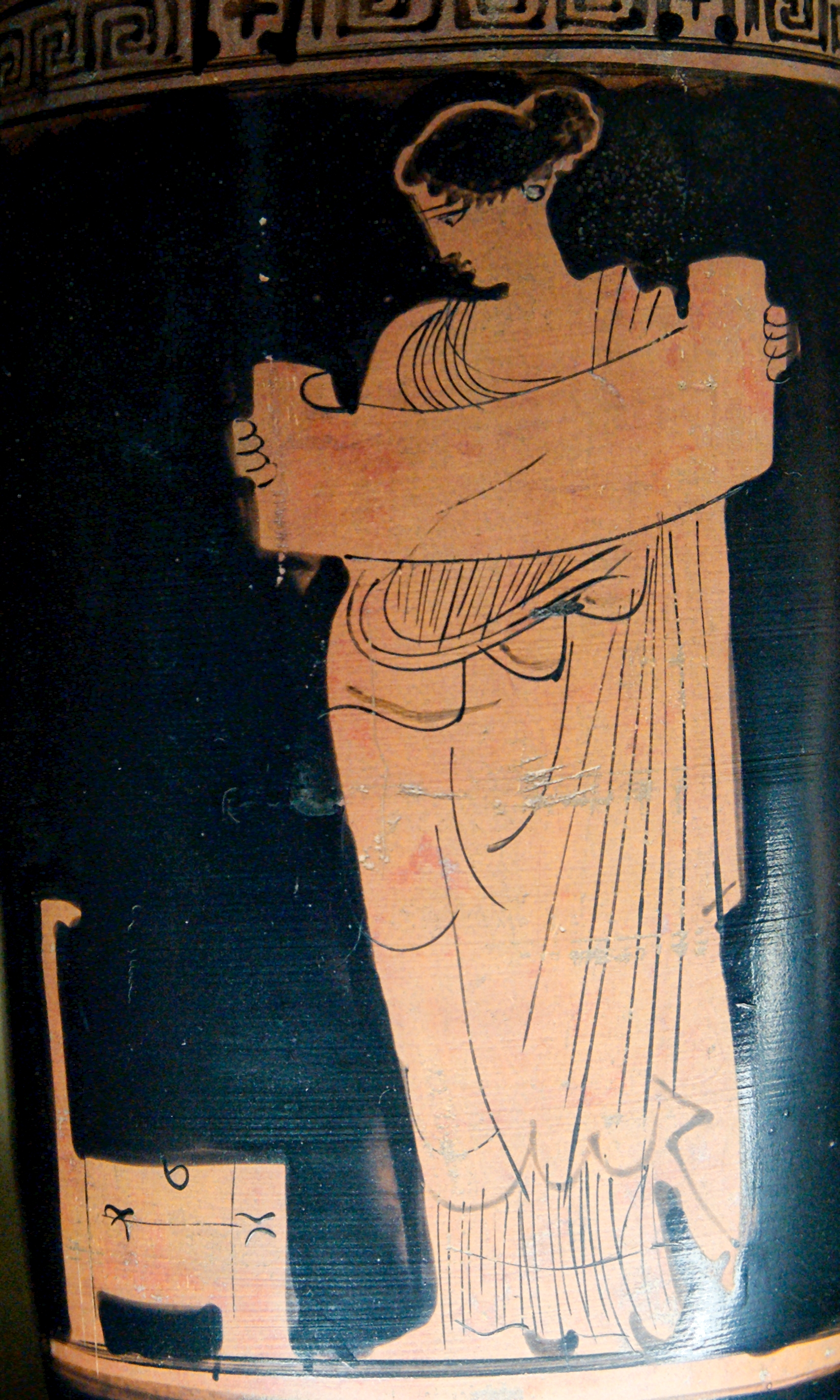|
Cicada (mythology)
Cicada lore and mythology is rich and varied as there are 2500 species of cicada throughout the world, many of which are undescribed and remain a mystery to science. Cicada has been prized as a delicacy, and are famed throughout the world for their song. The cicada is an animal replete with symbolism: recurring themes are resurrection, immortality, spiritual realization and spiritual ecstasy. For the Ancient Greeks and Romans they sang ecstatically, were sacred to Apollo and related to the :wikt:dionysiac, dionysiac bacchae and maenads. Eunomos and his cithara Egan (1994) cites several Greek sources that tell the story of Eunomos and the cicada. Eunomos, an accomplished cithara player and singer, was performing in a competition when one of the cithara strings snaps. A cicada as offering, :wikt:alights, alights on his cithara, sustaining the note of the broken string. Eunomos, thereby attributed :wikt:accolade, accolade, wins the competition. Aristotle Aristotle, fond of eat ... [...More Info...] [...Related Items...] OR: [Wikipedia] [Google] [Baidu] |
Cicada
The cicadas () are a superfamily, the Cicadoidea, of insects in the order Hemiptera (true bugs). They are in the suborder Auchenorrhyncha, along with smaller jumping bugs such as leafhoppers and froghoppers. The superfamily is divided into two families, the Tettigarctidae, with two species in Australia, and the Cicadidae, with more than 3,000 species Taxonomy (biology)#Taxonomic descriptions, described from around the world; many species remain undescribed. Cicadas have prominent eyes set wide apart, short antennae, and membranous front wings. They have an exceptionally loud song, produced in most species by the rapid buckling and unbuckling of drumlike tymbals. The earliest known fossil Cicadomorpha appeared in the Upper Permian period; extant species occur all around the world in temperate to tropical climates. They typically live in trees, feeding on watery sap from xylem tissue, and laying their eggs in a slit in the bark. Most cicadas are crypsis, cryptic. The vast majorit ... [...More Info...] [...Related Items...] OR: [Wikipedia] [Google] [Baidu] |
Rhetoric
Rhetoric () is the art of persuasion, which along with grammar and logic (or dialectic), is one of the three ancient arts of discourse. Rhetoric aims to study the techniques writers or speakers utilize to inform, persuade, or motivate particular audiences in specific situations. Aristotle defines rhetoric as "the faculty of observing in any given case the available means of persuasion" and since mastery of the art was necessary for victory in a case at law, for passage of proposals in the assembly, or for fame as a speaker in civic ceremonies, he calls it "a combination of the science of logic and of the ethical branch of politics". Rhetoric typically provides heuristics for understanding, discovering, and developing arguments for particular situations, such as Aristotle's three persuasive audience appeals: logos, pathos, and ethos. The five canons of rhetoric or phases of developing a persuasive speech were first codified in classical Rome: invention, arrangement, ... [...More Info...] [...Related Items...] OR: [Wikipedia] [Google] [Baidu] |
Cicadas
The cicadas () are a superfamily, the Cicadoidea, of insects in the order Hemiptera (true bugs). They are in the suborder Auchenorrhyncha, along with smaller jumping bugs such as leafhoppers and froghoppers. The superfamily is divided into two families, the Tettigarctidae, with two species in Australia, and the Cicadidae, with more than 3,000 species described from around the world; many species remain undescribed. Cicadas have prominent eyes set wide apart, short antennae, and membranous front wings. They have an exceptionally loud song, produced in most species by the rapid buckling and unbuckling of drumlike tymbals. The earliest known fossil Cicadomorpha appeared in the Upper Permian period; extant species occur all around the world in temperate to tropical climates. They typically live in trees, feeding on watery sap from xylem tissue, and laying their eggs in a slit in the bark. Most cicadas are cryptic. The vast majority of species are active during the day as adults, ... [...More Info...] [...Related Items...] OR: [Wikipedia] [Google] [Baidu] |
Robert Lawlor
Robert Lawlor (1938-2022) , Deborah Lawlor, '' Auroville Today'', March 2003 was a , ogist and author of several books. After training as a painter and a sculptor, he became a yoga student of and lived for many years in [...More Info...] [...Related Items...] OR: [Wikipedia] [Google] [Baidu] |
Andrew Dalby
Andrew Dalby, (born 1947 in Liverpool) is an English linguist, translator and historian who has written articles and several books on a wide range of topics including food history, language, and Classical texts. Education and early career Dalby studied Latin, French and Greek at the Bristol Grammar School and University of Cambridge. Here he also studied Romance languages and linguistics, earning a bachelor's degree in 1970. Dalby worked for fifteen years at Cambridge University Library, eventually specialising in Southern Asia. He gained familiarity with some other languages because of his work there, where he had to work with foreign serials and afterwards with South Asia and Southeast Asian materials. He also wrote articles on multilingual topics linked with the library and its collections. In 1982 and 1983, he collaborated with Sao Saimong in cataloguing the Scott Collection of manuscripts and documents from Burma (especially the Shan States) and Indochina. Dalby lat ... [...More Info...] [...Related Items...] OR: [Wikipedia] [Google] [Baidu] |
Tithonus
In Greek mythology, Tithonus ( or ; grc, Τιθωνός, Tithonos) was the lover of Eos, Goddess of the Dawn. He was a prince of Troy, the son of King Laomedon by the Naiad Strymo (Στρυμώ). The mythology reflected by the fifth-century vase-painters of Athens envisaged Tithonus as a '' rhapsode'', as attested by the lyre in his hand, on an oinochoe (wine jug) of the Achilles Painter, ''circa'' 470–460 BC. An asteroid (6998) has been named after Tithonus. Etymology Tithonus has been taken by the allegorist to mean ‘a grant of a stretching-out’ (from ''teinō'' and ''ōnė''), a reference to the stretching-out of his life, at Eos’s plea; but it is likely, rather, to have been a masculine form of Eos’s own name, Titonë – from ''titō'', ‘day and onë, ‘queen’ – and to have meant ‘partner of the Queen of Day’. Mythology Eos is said to have taken Tithonus, from the royal house of Troy, to be her lover.''Homeric Hymn to Aphrodite'', 218 ''ff''. The ... [...More Info...] [...Related Items...] OR: [Wikipedia] [Google] [Baidu] |
Daemon (classical Mythology)
Daimon or Daemon (Ancient Greek: , "god", "godlike", "power", "fate") originally referred to a lesser deity or guiding spirit such as the daimons of ancient Greek religion and mythology and of later Hellenistic religion and philosophy. The word is derived from Proto-Indo-European ''daimon'' "provider, divider (of fortunes or destinies)," from the root ''*da-'' "to divide". Daimons were possibly seen as the souls of men of the golden age acting as tutelary deities, according to entry at Liddell & Scott. See also daimonic: a religious, philosophical, literary and psychological concept. Description Daimons are lesser divinities or spirits, often personifications of abstract concepts, beings of the same nature as both mortals and deities, similar to ghosts, chthonic heroes, spirit guides, forces of nature, or the deities themselves (see Plato's ''Symposium''). According to Hesiod's myth, "great and powerful figures were to be honoured after death as a daimon…" A daimon is not ... [...More Info...] [...Related Items...] OR: [Wikipedia] [Google] [Baidu] |
Exegesis
Exegesis ( ; from the Greek , from , "to lead out") is a critical explanation or interpretation of a text. The term is traditionally applied to the interpretation of Biblical works. In modern usage, exegesis can involve critical interpretations of virtually any text, including not just religious texts but also philosophy, literature, or virtually any other genre of writing. The phrase ''Biblical exegesis'' can be used to distinguish studies of the Bible from other critical textual explanations. Textual criticism investigates the history and origins of the text, but exegesis may include the study of the historical and cultural backgrounds of the author, text, and original audience. Other analyses include classification of the type of literary genres presented in the text and analysis of grammatical and syntactical features in the text itself. Usage One who practices exegesis is called an ''exegete'' (; from the Greek ). The plural of exegesis is ''exegeses'' (). Adjectives ... [...More Info...] [...Related Items...] OR: [Wikipedia] [Google] [Baidu] |
Pan (mythology)
In ancient Greek religion and Greek mythology, mythology, Pan (; grc, wikt:Πάν, Πάν, Pán) is the god of the wild, shepherds and flocks, Pastoral#Pastoral music, rustic music and impromptus, and companion of the nymphs. He has the hindquarters, legs, and horns of a goat, in the same manner as a faun or satyr. With his homeland in rustic Arcadia (ancient region), Arcadia, he is also recognized as the god of fields, groves, wooded glens, and often affiliated with sex; because of this, Pan is connected to fertility and the season of spring. In Religion in ancient Rome, Roman religion and myth, Pan's counterpart was Faunus, a nature god who was the father of Bona Dea, sometimes identified as Fauna (goddess), Fauna; he was also closely associated with Silvanus (mythology), Sylvanus, due to their similar relationships with woodlands. In the 18th and 19th centuries, Pan became a significant figure in Romanticism, the Romantic movement of western Europe and also in the 20th-centu ... [...More Info...] [...Related Items...] OR: [Wikipedia] [Google] [Baidu] |
Muses
In ancient Greek religion and mythology, the Muses ( grc, Μοῦσαι, Moûsai, el, Μούσες, Múses) are the inspirational goddesses of literature, science, and the arts. They were considered the source of the knowledge embodied in the poetry, lyric songs, and myths that were related orally for centuries in ancient Greek culture. Melete, Aoede, and Mneme are the original Boeotian Muses, and Calliope, Clio, Erato, Euterpe, Melpomene, Polyhymnia, Terpsichore, Thalia, and Urania are the nine Olympian Muses. In modern figurative usage, a Muse may be a source of artistic inspiration. Etymology The word ''Muses'' ( grc, Μοῦσαι, Moûsai) perhaps came from the o-grade of the Proto-Indo-European root (the basic meaning of which is 'put in mind' in verb formations with transitive function and 'have in mind' in those with intransitive function), or from root ('to tower, mountain') since all the most important cult-centres of the Muses were on mountains or hills. R ... [...More Info...] [...Related Items...] OR: [Wikipedia] [Google] [Baidu] |
Nymphs
A nymph ( grc, νύμφη, nýmphē, el, script=Latn, nímfi, label=Modern Greek; , ) in ancient Greek folklore is a minor female nature deity. Different from Greek goddesses, nymphs are generally regarded as personifications of nature, are typically tied to a specific place or landform, and are usually depicted as maidens. They were not necessarily immortal, but lived much longer than human beings. They are often divided into various broad subgroups, such as the Meliae (ash tree nymphs), the Dryads (oak tree nymphs), the Naiads (freshwater nymphs), the Nereids (sea nymphs), and the Oreads (mountain nymphs). Nymphs are often featured in classic works of art, literature, mythology, and fiction. Since the Middle Ages, nymphs have been sometimes popularly associated or even confused with fairies. Etymology The Greek word has the primary meaning of "young woman; bride, young wife" but is not usually associated with deities in particular. Yet the etymology of the noun remai ... [...More Info...] [...Related Items...] OR: [Wikipedia] [Google] [Baidu] |

.jpg)





